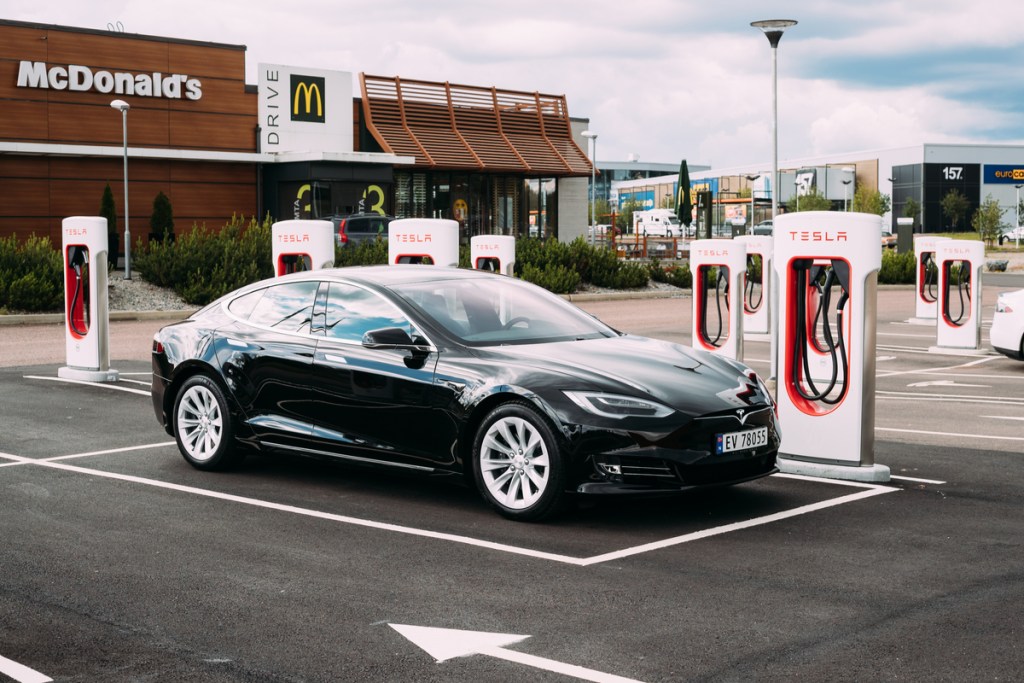Gas-powered vehicles fuel up at stations and come in different fuel grades from unleaded to unleaded premium. Electric vehicles need a charge, too. But did you know there are three levels of EV charging? Each charging level breaks down into speeds based on power delivered to the charging vehicle.
One thing to take away about EV charging speed: EVs charge at different rates on each level because each one accepts different power levels from the electric vehicle supply equipment, or ESVE, also known as the charger. There are a few other things about electric vehicle charging to keep in mind, aside from the different charge levels. Read on to learn all you need to know for your EV ownership.
Important facts to know about electric vehicle charging
When charging an electric vehicle, the ESVE communicates with the car. It initiates a query to determine the maximum power the vehicle can receive and the full output of the charger. Your vehicle determines the max charge input to avoid shorting the motor, so you never have to worry about overpowering your car.
Not all EV connectors are alike
Electric vehicle chargers vary by country and manufacturer. For the time being, the U.S. has standard ESVE connectors for every vehicle except for Tesla’s Level 1 and Level 2 chargers. Level 3 charging has three different standards currently in use:
- Tesla’s propriety plug
- Nissan and Mitsubishi’s Asian standard CHAdeMO
- Other manufacturers use the Combined Charging System, or CCS
Charging cables and ports
Every EV has a portable charger. Some ESVEs are Level 1 or Level 2. Others come with adapters to plug in and charge from Level 1 and Level 2 outlets.
Not all units are powerful enough based on individual consumer preference. If so, you can always purchase a more powerful charger. Check the power output of the standard charger and see how it matches up with your charging needs based on daily miles driven.
Tesla’s Supercharger and other EVs
Tesla Superchargers only charge Tesla vehicles. The Supercharger network is a proprietary network installed by Tesla for Tesla customers only. If you’re a Tesla owner, you don’t have to use the Supercharger in a pinch.
Instead, you can buy the $400 adapter that allows Tesla owners to plug into CHAdeMO DC fast chargers. Tesla also plans to sell a combo adapter so Tesla owners can also access DC fast chargers with the combo standard.

Level 1 charging: 120-volt EVs
Level 1 charging uses a standard 120-volt household outlet. This means you can charge at home and avoid the fees of setting on a public ESVE. All you have to do is plug the right connector and related equipment into the wall.
For levels of EV charging, Level 1 is the slowest way to charge an electric vehicle. It adds between 3 and 5 miles of range per hour. This is an ideal solution for overnight charging. It’s also better for plug-in hybrid electric vehicles because of their smaller batteries.
EVs have much larger batteries, which means Level 1 charging is too slow for most daily charging unless the vehicle isn’t used for driving very far daily. If you’ve got a long daily commute, you’ll need a higher charging level.
Level 2 charging: 208-volt to 240-volt EVs
Level 2 charging is the most commonly used level for daily EV charging. Its charging equipment is easy to install at home, the workplace, and in public places like shopping plazas and train stations. Level 2 charging refills between 12 and 80 miles of range per hour, depending on the ESVE’s power output and the vehicle’s maximum charge rate.
Most EV owners install Level 2 chargers at home. It charges the vehicle up to 10 times faster than Level 1 charging. You can get a full overnight charge with this electric vehicle charging level.
Most Level 2 chargers offer 80 amps of power. This power level requires a 100-amp, 208- to 240-volt dedicated circuit and a supply line from the breaker box. A 40-amp charger that delivers 9.6 kilowatts to the EV is cheaper and does the same job. Or, the 48-amp unit charges slightly faster at 11.5 kilowatts but requires a heavier gauge wire and hardwiring for NEC compliance.
Level 2 chargers cost anywhere from $250 and $1,000. Installation ranges from $200 to $1,000 or much higher if you need electrical work done on your home. A potential tax credit might cut the cost of an installation like this.

Level 3 charging: 400-volt to 900-volt EVs
Level 3 electric vehicle charging includes DC fast charging and supercharging. It’s used for CCS or combo chargers, CHAdeMO, and Tesla. With a charging speed of 3 to 20 miles per minute, it’s the fastest charge available. For now, you can only get this kind of charge in public charging stations (with charge fees).
Level 3 charging uses DC, whereas Level 1 and Level 2 use AC. DC fast chargers cost tens of thousands of dollars. Even if your residence has 400-volt electricity service, the installation would likely cost more than your EV.
Picking the best electric vehicle charging level for you
You’ll likely want to invest in a Level 2 charger. If you’re isolated or inconveniently far from a Level 3 charger, a Level 2 charger will save you tons in charging fees. Make sure you consult an electrician when installing ESVE at your home or workplace. Check on tax incentives and savings discounts to get the most out of your EV ownership.


